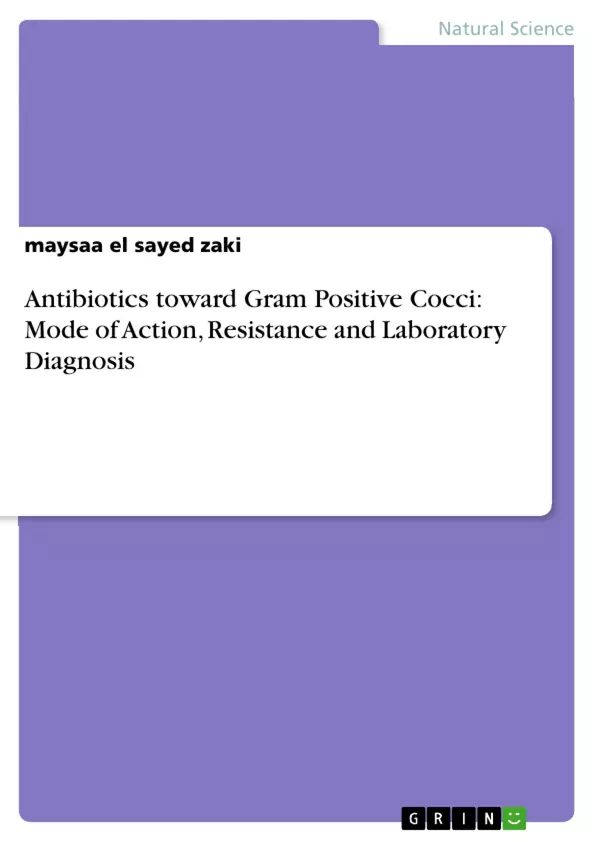
Antibiotics toward Gram Positive Cocci: Mode of Action, Resistance and Laboratory Diagnosis
Fachbuch, 2013
179 Seiten
Leseprobe
Table of Contents
- Chapter One: Gram-Positive Organisms as Human Pathogens
- Chapter Two: Antibiotics against Gram-positive cocci: Mechanism of action
- Chapter Three: Mechanisms of Antibiotic Resistance
- Chapter Four: Antimicrobial Susceptibility Testing
Objectives and Key Themes
This work aims to provide a comprehensive overview of Gram-positive cocci, their role as human pathogens, the mechanisms of action of antibiotics against them, and the development of antibiotic resistance. The text explores the clinical significance of these bacteria and the challenges posed by their resistance to treatment.
- Gram-positive cocci as human pathogens and their clinical significance
- Mechanisms of action of antibiotics against Gram-positive cocci
- Mechanisms of antibiotic resistance in Gram-positive cocci
- Antimicrobial susceptibility testing and its implications
- The impact of modern lifestyles and medical advancements on the prevalence and presentation of Gram-positive infections
Chapter Summaries
Chapter One: Gram-Positive Organisms as Human Pathogens: This chapter establishes Gram-positive organisms, particularly staphylococci, enterococci, and streptococci, as the most prevalent bacterial pathogens in humans. It highlights the significant impact of these organisms throughout history, noting how diseases like pneumonia and scarlet fever were once major causes of mortality. The chapter also discusses the shift in the epidemiology of these infections due to advancements in antimicrobial agents and vaccination programs. Finally, it points out the varying degrees of antimicrobial susceptibility among Gram-positive organisms, with some remaining sensitive while others, like staphylococci and enterococci, have developed significant resistance. The discussion of Staphylococci, specifically *S. aureus*, details its role in various serious infections and its remarkable ability to develop resistance, highlighting its clinical importance. Coagulase-negative staphylococci (CONS) are also covered, illustrating their increasing recognition as causative agents in various infections, despite their traditionally lower virulence compared to *S. aureus*. The chapter emphasizes the evolving nature of infectious disease and the continued importance of understanding Gram-positive pathogens.
Chapter Two: Antibiotics against Gram-positive cocci: Mechanism of action: [This chapter summary would discuss the mechanisms of action of various antibiotics targeting Gram-positive cocci. A detailed explanation of the different antibiotic classes and their specific targets within the bacterial cells would be provided, along with examples of how each class functions to inhibit bacterial growth or kill the bacteria. The text would likely describe the cellular processes targeted by these antibiotics (e.g., cell wall synthesis, protein synthesis, DNA replication) and the consequences of antibiotic action on these processes. The summary should explain the relationship between antibiotic structure and mechanism of action, perhaps covering specific examples of antibiotic families and their variations in effectiveness against different Gram-positive species. This would likely lead into a discussion of the differences in antibiotic mechanisms of action based on the target species and the factors that influence susceptibility.]
Chapter Three: Mechanisms of Antibiotic Resistance: [This chapter summary would delve into the various ways Gram-positive cocci develop resistance to antibiotics. It would likely cover different resistance mechanisms such as enzymatic inactivation, target modification, efflux pumps, and reduced permeability. The summary should describe specific examples of each mechanism, detailing how mutations or other genetic changes lead to antibiotic resistance. A discussion of the genetic basis of resistance would likely be included, highlighting the role of horizontal gene transfer (e.g., plasmids, transposons) in the spread of resistance genes. The summary would emphasize the implications of these resistance mechanisms for clinical practice, and potentially include an overview of emerging resistance mechanisms or strategies employed by bacteria to overcome antibiotic treatments.]
Chapter Four: Antimicrobial Susceptibility Testing: [This chapter summary would explain the different methods used to determine the susceptibility of Gram-positive cocci to various antibiotics. It would likely describe common laboratory techniques such as broth dilution, agar dilution, and disk diffusion methods, explaining how Minimum Inhibitory Concentration (MIC) and Minimum Bactericidal Concentration (MBC) values are determined and interpreted. The summary should detail the importance of these tests for guiding appropriate antibiotic treatment choices, highlighting the clinical utility of susceptibility testing. It might also cover aspects of quality control and standardization of methods, addressing the potential sources of variability and the importance of accurate results for patient care.]
Keywords
Gram-positive cocci, antibiotic resistance, mechanisms of action, antimicrobial susceptibility testing, Staphylococcus aureus, enterococci, streptococci, bacterial pathogens, clinical microbiology, infection control, superbugs, MRSA, VRE.
Frequently Asked Questions: A Comprehensive Language Preview of Gram-Positive Cocci
What is the focus of this text?
This text provides a comprehensive overview of Gram-positive cocci, their role as human pathogens, the mechanisms of action of antibiotics against them, and the development of antibiotic resistance. It explores the clinical significance of these bacteria and the challenges posed by their resistance to treatment.
What topics are covered in each chapter?
Chapter One: Gram-Positive Organisms as Human Pathogens focuses on the prevalence of Gram-positive bacteria (staphylococci, enterococci, streptococci) as human pathogens, their historical impact, the changing epidemiology of infections, and varying degrees of antimicrobial susceptibility, with a detailed look at Staphylococcus aureus and coagulase-negative staphylococci (CONS).
Chapter Two: Antibiotics against Gram-positive cocci: Mechanism of action details the mechanisms by which various antibiotics target Gram-positive cocci, explaining different antibiotic classes, their targets within bacterial cells, and the consequences of their action on cellular processes. It explores the relationship between antibiotic structure and mechanism of action.
Chapter Three: Mechanisms of Antibiotic Resistance examines how Gram-positive cocci develop resistance to antibiotics, covering mechanisms like enzymatic inactivation, target modification, efflux pumps, and reduced permeability. It delves into the genetic basis of resistance and the implications for clinical practice.
Chapter Four: Antimicrobial Susceptibility Testing explains methods used to determine the susceptibility of Gram-positive cocci to antibiotics (broth dilution, agar dilution, disk diffusion), the interpretation of MIC and MBC values, and the importance of these tests for guiding treatment.
What are the key themes explored in this text?
Key themes include Gram-positive cocci as human pathogens and their clinical significance; mechanisms of action of antibiotics against them; mechanisms of antibiotic resistance; antimicrobial susceptibility testing and its implications; and the impact of modern lifestyles and medical advancements on the prevalence and presentation of Gram-positive infections.
What are the main keywords associated with this text?
Gram-positive cocci, antibiotic resistance, mechanisms of action, antimicrobial susceptibility testing, Staphylococcus aureus, enterococci, streptococci, bacterial pathogens, clinical microbiology, infection control, superbugs, MRSA, VRE.
What is the overall objective of this work?
The objective is to provide a complete understanding of Gram-positive cocci, their role in human infections, antibiotic treatment strategies, and the challenges posed by antibiotic resistance. It aims to equip readers with knowledge essential for managing infections caused by these bacteria.
Who is the intended audience for this text?
This text appears geared towards students and researchers in clinical microbiology, infectious disease, and related fields. The detailed explanations and focus on mechanisms suggest an academic or professional audience.
Details
- Titel
- Antibiotics toward Gram Positive Cocci: Mode of Action, Resistance and Laboratory Diagnosis
- Autor
- maysaa el sayed zaki (Autor:in)
- Erscheinungsjahr
- 2013
- Seiten
- 179
- Katalognummer
- V231361
- ISBN (eBook)
- 9783656484523
- ISBN (Buch)
- 9783656484530
- Dateigröße
- 2127 KB
- Sprache
- Englisch
- Schlagworte
- antibiotics gram positive cocci mode action resistance laboratory diagnosis
- Produktsicherheit
- GRIN Publishing GmbH
- Preis (Ebook)
- US$ 43,99
- Preis (Book)
- US$ 57,99
- Arbeit zitieren
- maysaa el sayed zaki (Autor:in), 2013, Antibiotics toward Gram Positive Cocci: Mode of Action, Resistance and Laboratory Diagnosis, München, Page::Imprint:: GRINVerlagOHG, https://www.diplomarbeiten24.de/document/231361
- Autor werden
- Ihre Optionen
- Vertriebskanäle
- Premium Services
- Autorenprofil
- Textarten und Formate
- Services für Verlage, Hochschulen, Unternehmen

- © GRIN Publishing GmbH.
- Alle Inhalte urheberrechtlich geschützt. Kopieren und verbreiten untersagt.
- info@grin.com
- AGB
- Open Publishing
Der GRIN Verlag hat sich seit 1998 auf die Veröffentlichung akademischer eBooks und Bücher spezialisiert. Der GRIN Verlag steht damit als erstes Unternehmen für User Generated Quality Content. Die Verlagsseiten GRIN.com, Hausarbeiten.de und Diplomarbeiten24 bieten für Hochschullehrer, Absolventen und Studenten die ideale Plattform, wissenschaftliche Texte wie Hausarbeiten, Referate, Bachelorarbeiten, Masterarbeiten, Diplomarbeiten, Dissertationen und wissenschaftliche Aufsätze einem breiten Publikum zu präsentieren.
Kostenfreie Veröffentlichung: Hausarbeit, Bachelorarbeit, Diplomarbeit, Dissertation, Masterarbeit, Interpretation oder Referat jetzt veröffentlichen!
- GRIN Verlag GmbH
-
- Nymphenburger Str. 86
- 80636
- Munich, Deutschland
- +49 89-550559-0
- +49 89-550559-10
- info@grin.com
-









